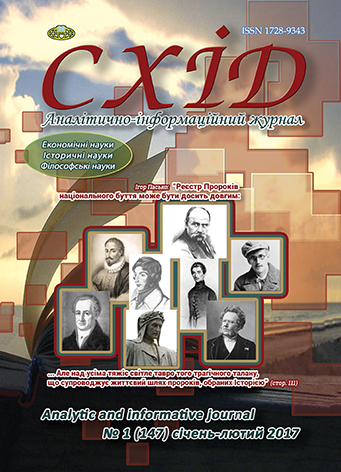The countries of Central and Eastern Europe: the experience of the interaction policy for the sustainable development purpose
DOI:
https://doi.org/10.21847/1728-9343.2017.1(147).144075Keywords:
Central and Eastern European countries, sustainable development policy, economical development, ecological development, social developmentAbstract
The experience of post-communist transformation and the concept of stoic development implementation in the countries of Central and Eastern Europe are particularly relevant for Ukraine. Most of the countries in the region have made a significant progress in the short-term run; their population has been actively involved in transformational processes. They succeeded in instant mastering of a mature market economy model, avoiding the negative manifestations of bureaucratic, oligarchic or criminal capitalism, which, unfortunately, the Ukrainian society experiences itself. Their sustainable development strategies are based on the ideas of market competition, the regulatory role of the state, and the liberal socially-oriented market economy. The purpose of the article is to analyze the constituent parts of the policy of the countries of Central and Eastern Europe in the context of sustainable development - economic, environmental and social.
In the analysis of economic policy the achievements of the studied countries such as macroeconomic transformation, domestic investment and consumer demand, quality of labor resources, price liberalization have been noted. The success of environmental policy is to simultaneously conduct it with effective economic transformations, an understanding of its evolutionary nature and the awareness of the society of the risks associated with environment pollution. The greatest achievement of social policy is the creation of a social protection system based on the Western Europe model and the following directions development: social assistance to the poor; universal (general) assistance provided to all citizens; social insurance covering payroll employees and other contributors.Downloads
References
Garvey, Tom (2002). EU Enlargement: Is It Sustainable? In: S. Crisen and J. Carmin (eds.). EU Enlargement and Environmental Quality: Central and Eastern Europe & Beyond, Washington, DC: Woodrow Wilson International Center for Scholars, 53-62 pp. (eng).
Bell, Ruth Greenspan (2002). EU Membership: Boon or Bane for the Environmental Community in the Accession Countries? In: Crisen, S. and J. Carmin (eds.), EU Enlargement and Environmental Quality: Central and Eastern Europe & Beyond, Washington, DC: Woodrow Wilson International Center for Scholars, 82-91 pp. (eng).
Strongylis, George (2013). European Union: A New Economic Development Model. 4. Available at: https://biopolitics.gr/biowp/wp-content/uploads/2013/04/strong.pdf.
Jehlicka, Petr and Tickle, Andrew (2002). Environmental policy and European Union enlargement: a state-centered approach, Conference: EU Enlargement and Environmental Quality in Central and Eastern Europe and Beyond, March 14/, Available at: http://wwics.si.edu/ees/special/2002/ejihlicka.pdf.
Vovk, Viktor (2003). September. Sustainable Development for the Second World: Ukraineand the Nations in Transition. Worldwatch Paper 167. Washington, D.C.: World watch Institute (eng).
Vovk, Viktor and Prugh, Tomas (July/August 2003). Red Past. Green Future? Sustainable Development for Ukraine and the Post-communist Nations. World Watch magazine (eng).
Fedun, Yu. B. (2014). Formation and implementation of the policy of sustainable development in the candidate countries for EU membership. Visnyk of Lviv National University. Series of international relations. Issue 36. Part 1. P. 70-81. Available at: http://intrel.lnu.edu.ua/wp-content/uploads/2014/11/VLNU_Mv_2014_361__10-1.pdf.
Unleashing Prosperity: Productivity Growth in Eastern Europe and the Former Soviet Union, World Bank, Washington. 2008, p. 42. Available at: http://siteresources.worldbank.org/ECAEXT/Resources/publications/UnleashingProsperity.pdf.
Kudrov, V. M. (2001). Central and Eastern Europe: ten years of change. Obshchestvennyye nauki i sovremennost. No. 1. Available at: http://ecsocman.hse.ru/data/764/688/1231/004kUDROW.pdf.
Shvayko, M.L. (2007). Finance of foreign countries. KNU named after VN Karazin, Kharkiv, 133 pp. Available at: http://pravo.studio/osnovyi-finansov/sotsialno-ekonomicheskie-protsessyi-stranah-41748.html.
Vasilishina, N.V. (2015). Current trends in the socio-economic development of the countries of Central and Eastern Europeas a basis for cooperation with the international labor organization. Baikal Research Journal. 1. Available at: https://cyberleninka.ru/article/n/sovremennye-tendentsii-sotsialno-ekonomicheskogo-razvitiya-stran-tsentralnoy-i-vostochnoy-evropy-kak-osnova-sotrudnichestva-s.
The right to social security. Text book. Available at: https://studme.org/85945/sotsiologiya/pravo_sotsialnogo_obespecheniya.
Vovk, V. (2015). Central and Eastern European countries joining the European Union: impact on environmental policy and prospects for sustainable development (Lessons for Ukraine). Available at: http://www.csi.org.ua/book/1097136922_EU%20Enlargement%20&%20Sustainable%20Development%.
Downloads
Published
How to Cite
Issue
Section
License
Copyright (c) 2018 Denis Tarasenko

This work is licensed under a Creative Commons Attribution-NonCommercial-NoDerivatives 4.0 International License.
1. Authors bear responsibility for the accuracy of facts, quotations, numbers and names used.
2. Manuscripts are not sent back.
3. The publisher does not always agree with the authors' opinion.
4. The authors reserve the right to authorship of the work and pass the first publication right of this work to the journal under the terms of a Creative Commons Attribution-NonCommercial-NoDerivatives 4.0 International License. This license allows others to distribute (copy) the published work for non-commercial purposes, provided there is mandatory attribution to its authors and a link to the first publication in our journal.
5. The authors have the right to conclude separate supplement agreements that relate to non-exclusive work distribution in the form in which it has been published by the journal (for example, to upload the work to the online storage of the journal or publish it as part of a monograph), provided that the reference to the first publication of the work in this journal is included.

